| Home | Nature Weekly Index |
12 June 2016 | Walk at the Park |
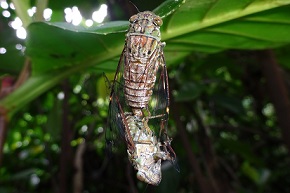 Last Sunday morning, I was fortunate to witness a pair of mating
cicada (Purana usnani) for the first time. They were
hanging on the edge of a broad leaf from
Simpoh Air shrub (Dillenia suffruticosa). Cicada is very common
at the Admiralty Park where I saw this mating pair. So far, I had 2 unusual encounters with cicadas; one was the
sighting of Golden Black Cicada (Huechys fusca) along
the way to the Tree Top Walk in April 2014 while the other was the sighting of
a moulting cicada at Bukit Timah Nature Reserve in July 2010.
Last Sunday morning, I was fortunate to witness a pair of mating
cicada (Purana usnani) for the first time. They were
hanging on the edge of a broad leaf from
Simpoh Air shrub (Dillenia suffruticosa). Cicada is very common
at the Admiralty Park where I saw this mating pair. So far, I had 2 unusual encounters with cicadas; one was the
sighting of Golden Black Cicada (Huechys fusca) along
the way to the Tree Top Walk in April 2014 while the other was the sighting of
a moulting cicada at Bukit Timah Nature Reserve in July 2010.
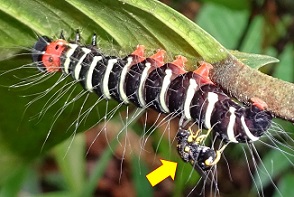 Admiralty Park is the home to several common fig trees, which could be easily recognised when they were bearing fruits. As I shared in
August 2015, one of them was
Common Yellow Stem Fig (Ficus fistulosa). Occasionally, massive attack
on its leaves by the
Owlet Moth caterpillar (Asota Plana)
could be seen. This time round, I found 2 caterpillars on a seedling of this fig tree. Nothing unusual until I saw a tiny
fly-like insect trying to land on a caterpillar. It made several attempts and eventually landed on the
tail region of the caterpillar. After looking at the magnified picture, I was quite certain that it was a parasitic wasp,
probably a Brachymeria species, trying to deposit some eggs in the caterpillar.
Admiralty Park is the home to several common fig trees, which could be easily recognised when they were bearing fruits. As I shared in
August 2015, one of them was
Common Yellow Stem Fig (Ficus fistulosa). Occasionally, massive attack
on its leaves by the
Owlet Moth caterpillar (Asota Plana)
could be seen. This time round, I found 2 caterpillars on a seedling of this fig tree. Nothing unusual until I saw a tiny
fly-like insect trying to land on a caterpillar. It made several attempts and eventually landed on the
tail region of the caterpillar. After looking at the magnified picture, I was quite certain that it was a parasitic wasp,
probably a Brachymeria species, trying to deposit some eggs in the caterpillar.
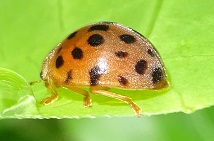
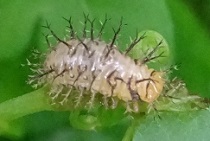 Another interesting encounter was the larva of the
Twenty-eight Spot Ladybird (Henosepilachna vigintioctopunctata)
on the Mile-a-minute creeper (Mikania micrantha). Contrary to the
good things that we often heard about ladybird beetles being a good-to-have companion in the garden, this particular one was
considered a serious pest to crop plants from the Solanaceae family such as
egg plant (Solanum melongena). For this reason
and because of the importance of egg plant as staple vegetable in India, Pakistan and Bangladesh, there were many publications from that region
that devoted to finding ways to eradicate this beetle. However, I had yet to find a report that link this beetle to the
Mile-a-minute creeper.
Another interesting encounter was the larva of the
Twenty-eight Spot Ladybird (Henosepilachna vigintioctopunctata)
on the Mile-a-minute creeper (Mikania micrantha). Contrary to the
good things that we often heard about ladybird beetles being a good-to-have companion in the garden, this particular one was
considered a serious pest to crop plants from the Solanaceae family such as
egg plant (Solanum melongena). For this reason
and because of the importance of egg plant as staple vegetable in India, Pakistan and Bangladesh, there were many publications from that region
that devoted to finding ways to eradicate this beetle. However, I had yet to find a report that link this beetle to the
Mile-a-minute creeper.
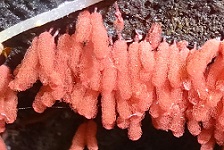
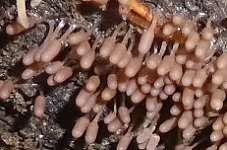
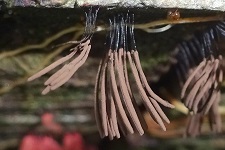 Finally, I came across an unusual slime mould --- the
Carnival Candy Slime Mold (Arcyria denudate). The mature
tubular fruiting bodies were reddish pink while the immature form was brown in colour. They were presented as a reddish
patches on the cut surface of a large log located at the side of the track. While taking a closer look at this slime mould,
I discovered another slime mould growing in their midst --- the Chocolate Tube Slime (Stemonitis species). The Chocolate
Tube Slime was not detected earlier as its colour blend well with that of the wood that it was growing on.
Finally, I came across an unusual slime mould --- the
Carnival Candy Slime Mold (Arcyria denudate). The mature
tubular fruiting bodies were reddish pink while the immature form was brown in colour. They were presented as a reddish
patches on the cut surface of a large log located at the side of the track. While taking a closer look at this slime mould,
I discovered another slime mould growing in their midst --- the Chocolate Tube Slime (Stemonitis species). The Chocolate
Tube Slime was not detected earlier as its colour blend well with that of the wood that it was growing on.